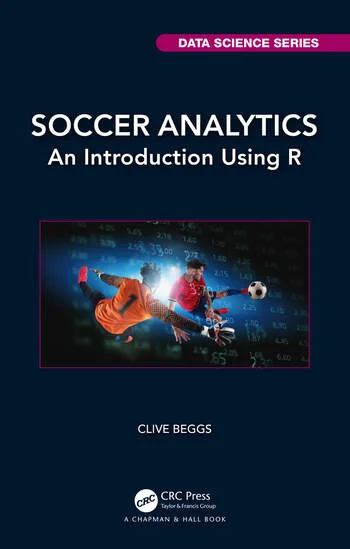With an estimated 250 million players worldwide, and a further 3.5 billion people watching soccer games [1], there is considerable interest in soccer statistics amongst fans, with many betting on the outcome of matches. It is therefore not surprising that many popular books have been written exploring the mathematics of soccer. However, few of these supply any details on how soccer data can be analysed in real-life. Consequently, those wishing to learn how analyse soccer data and make predictions, either have to enrol on expensive courses, or alternatively trawl the Internet to teach themselves.
A new book, Soccer Analytics: An Introduction Using R, by Clive Beggs addresses this shortcoming, and is a comprehensive introduction to soccer analytics aimed at all those wanting to learn how to analyse soccer data. The book takes a practical route one approach designed to show readers how to successfully tackle a range of soccer related problems using the easy-to-learn computer language R. Through a series of easy-to-follow examples containing fully working code, the book explains how R can be used to:
- Download and edit soccer data
- Produce graphics and statistics
- Predict match outcomes
- Predict final league position
- Formulate betting strategies
- Rank teams
- Construct passing networks to assess player performance
- Analyse performance metrics
- Identify what is important and what is not important
As such, Soccer Analytics: An Introduction Using R is a comprehensive introduction to soccer analytics. The book is aimed at all those interested in analysing soccer data, be they fans, gamblers, coaches, sports scientists, or data scientists and statisticians wishing to pursue a career in professional soccer. It aims to equip the reader with the knowledge and skills required to confidently analyse soccer data using R, all in a few easy lessons.
The book is an introductory text and as such no prior knowledge of coding is required to learn from it. For those unfamiliar with R, the book includes a comprehensive tutorial to enable the reader to quickly learn how to code, so that they can analyse data for themselves. The book also contains numerous examples of fully working code designed to tackle a range of problems commonly encountered in soccer.
References
- Statista. Soccer in Australia – Statistics and Facts. Statista Research Department. 10th January 2024. [https://www.statista.com/topics/10627/soccer-in-australia/#topicOverview]
About the author
Clive Beggs is Emeritus Professor of Applied Physiology in the Carnegie School of Sport at Leeds Beckett University in the UK. He is a PhD bio-engineer and physiologist, who has worked for many years with leading research teams around the world on a wide variety of medical and sport related projects – publishing many scientific papers in both fields. With a background in mathematical modelling of clinical and biological systems, he also has expertise in data analytics and machine learning, which he regularly uses in his sport performance work. Clive is both an amateur runner and soccer fan, and it is his life-long interest in sport and mathematics that has prompted him to write this book.
